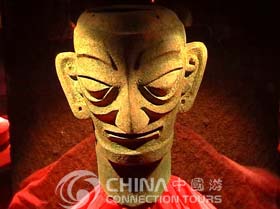
 The site of Sanxingdui is located in the city of Guanghan, 40 km from Chengdu. It is recognized as one of the most important ancient remains in the world for its vast size, lengthy period and enriched cultural contents. The first Sanxingdui relics were discovered by a farmer in 1929 and excavation has continued ever since. During this period, generations of archaeologists have worked on the discovery and research of the Sanxingdui culture. In 1986, two major sacrificial pits were found and they aroused widespread academic attention around the world. Because there are no texts found, nor is there any mention of this culture in the records of other countries. Analysis of lead and other elements in the bronzes indicates sources similar to those of other cultures along the lower reaches of the Yangtze River. At this point, however, the unique culture remains a mystery. The most important discovery is bronze masks. They include man-face masks and vertical-eyed masks with a pair of post-shaped bulging eyes and a pair of fully expanded ears. On their foreheads, a kui-dragon (a special shape) crown was castled.
The site of Sanxingdui is located in the city of Guanghan, 40 km from Chengdu. It is recognized as one of the most important ancient remains in the world for its vast size, lengthy period and enriched cultural contents. The first Sanxingdui relics were discovered by a farmer in 1929 and excavation has continued ever since. During this period, generations of archaeologists have worked on the discovery and research of the Sanxingdui culture. In 1986, two major sacrificial pits were found and they aroused widespread academic attention around the world. Because there are no texts found, nor is there any mention of this culture in the records of other countries. Analysis of lead and other elements in the bronzes indicates sources similar to those of other cultures along the lower reaches of the Yangtze River. At this point, however, the unique culture remains a mystery. The most important discovery is bronze masks. They include man-face masks and vertical-eyed masks with a pair of post-shaped bulging eyes and a pair of fully expanded ears. On their foreheads, a kui-dragon (a special shape) crown was castled.
The largest one of the vertical-eyed masks is 65 cm high and 138 cm wide. It is really the King of all masks in the world. It is considered a combination of gods and a human being; this was regarded as the idol of the ancient Shu people. Animal-face masks are another kind of special structure, with nine kinds  altogether. Animal-face masks have Kui-dragon ears, open mouths and grinning teeth, and look like neither a human being nor any known animal. They were considered a kind of god by ancient people. The excavated Sanxingdui remains are the largest among all the early Ba Shu cultural remains. This excavation pushes Ba Shu history back a further 1,000 years to the time from 1,000 BC to 2,000 BC. The exquisite arrangements and the house remains show that agriculture, animal husbandry, handicrafts and architecture had developed by that time, creating the foundations for a civilized society. Among large numbers of Chinese cultural relics, Sanxingdui is considered one of those with the greatest historical and scientific significance.
altogether. Animal-face masks have Kui-dragon ears, open mouths and grinning teeth, and look like neither a human being nor any known animal. They were considered a kind of god by ancient people. The excavated Sanxingdui remains are the largest among all the early Ba Shu cultural remains. This excavation pushes Ba Shu history back a further 1,000 years to the time from 1,000 BC to 2,000 BC. The exquisite arrangements and the house remains show that agriculture, animal husbandry, handicrafts and architecture had developed by that time, creating the foundations for a civilized society. Among large numbers of Chinese cultural relics, Sanxingdui is considered one of those with the greatest historical and scientific significance.

